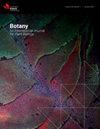同类植物:宿主特异性全寄生虫的种内自寄生
IF 1.3
4区 生物学
Q3 PLANT SCIENCES
引用次数: 0
摘要
种内自寄生,即一种寄生虫作为同一物种另一个体的宿主的现象,是半寄生开花植物之间的一种很好的相互作用。在这里,我描述了一个罕见的自寄生案例,在维吉尼亚(Orobanchaceae),一种全寄生植物,通常只在Fagus grandfolia(壳斗科)的根上发现。通过显微断层扫描和解剖分析证实了自寄生关系。结果表明,两株维吉尼亚金丝莲植物之间存在血管连接,并且溶质从一株植物到另一株植物的通道畅通无阻,从而表明自寄生连接是完全有效的。虽然附近寄主的几段根与寄生虫的不定根纠缠在一起,但没有检测到寄主与寄生虫的维管连接。此外,对数字化植物标本的分析表明,尽管罕见,但在E. virginia中观察到的自寄生关系并不是一个案例。共分析了3097份数字化标本馆标本,其中1.69%观察到可能包含自寄生连接。这些结果为寄生开花植物寄主特异性和吸器发育过程的研究提供了新的线索。本文章由计算机程序翻译,如有差异,请以英文原文为准。
Cannibal plants: intraspecific autoparasitism among host-specific holoparasites
Intraspecific autoparasitism, the phenomenon in which a parasite serves as the host for another individual of the same species, is a well described interaction among hemi-parasitic flowering plants. Here I describe a rare case of autoparasitism in Epifagus virginiana (Orobanchaceae), a holo-parasitic plant normally found exclusively on the roots of Fagus grandifolia (Fagaceae). Confirmation of the autoparasitic relationship was obtained through micro-tomography and anatomical analyses. Results show the presence of vessel connections between the two E. virginiana plants and the unobstructed passage of solutes from one plant to another, thus suggesting the autoparasitic connection to be fully functional. While several segments of nearby host roots were entangled with the adventitious roots of the parasite, no parasite-host vascular connection was detected. Additionally, an analysis of digitized herbarium specimens showed that albeit rare, the observed autoparasitic relationship in E. virginiana is not a one-of case. A total of 3,097 digitized herbarium specimens were also analyzed, among which 1.69% were observed to potentially include an autoparasitic connection. Altogether, these results provide new clues for the investigation of host-specificity and haustorium development processes in parasitic flowering plants.
求助全文
通过发布文献求助,成功后即可免费获取论文全文。
去求助
来源期刊

Botany
生物-植物科学
CiteScore
2.20
自引率
9.10%
发文量
48
期刊介绍:
Botany features comprehensive research articles and notes in all segments of plant sciences, including cell and molecular biology, ecology, mycology and plant-microbe interactions, phycology, physiology and biochemistry, structure and development, genetics, systematics, and phytogeography. It also publishes methods, commentary, and review articles on topics of current interest, contributed by internationally recognized scientists.
 求助内容:
求助内容: 应助结果提醒方式:
应助结果提醒方式:


